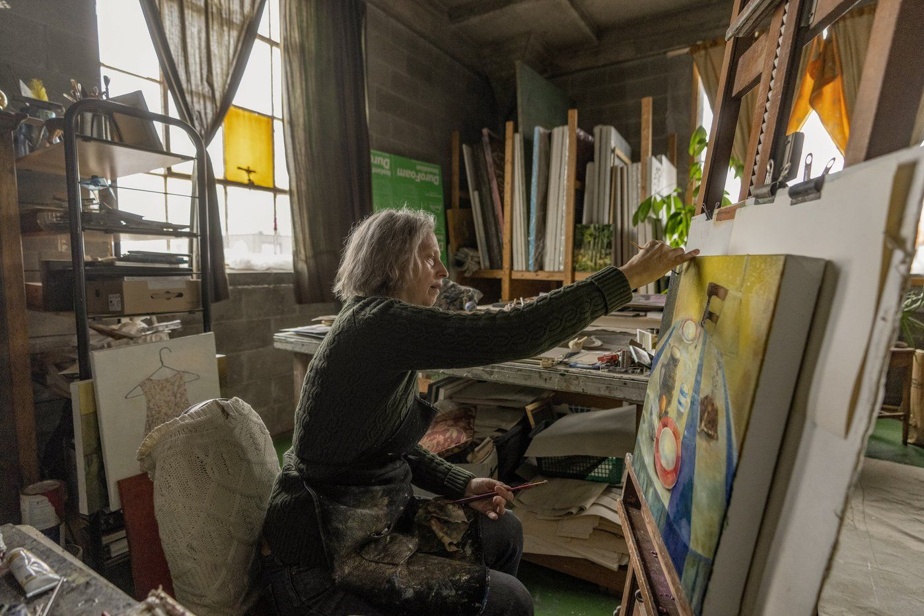(Montreal) The landscape outside painter Frances Foster’s studio has changed a lot in 32 years: over time, old railway stations and dilapidated factories have given way to trendy businesses, new residents and cars luxury.
The interior, however, has never seemed so empty.
At one time, Mme Foster shared the studio located in a former industrial building with around ten other artists. But today there are just two of them left, having barely survived an eviction attempt that forced all the other tenants to leave over the past three years.
The owners abandoned their eviction proceedings last year “because they had achieved their goal of evicting the majority of the artists, some of whom had lived in the building for more than 20 years,” she explains.
Montreal, named a UNESCO City of Design in 2006, has long been recognized as a paradise for artists, thanks to its dynamic cultural scene and unbeatable rents.
However, as rents rise and old industrial neighborhoods are redeveloped, some artists have no choice but to leave where they created.
When Mme Foster moved into the building, the area around it was pretty much abandoned. “It was a pretty scary neighborhood,” she admits.

PHOTO CHRISTINNE MUSCHI, THE CANADIAN PRESS
But around 2021, the area became gentrified, leading the building’s owner to decide to redevelop it and push artists to leave. Mme Foster still pays less than $1,000 for monthly rent.
It’s an all-too-common scenario, according to the executive director of a group that represents the province’s visual artists.
“What we already know is that the situation of artists is increasingly precarious,” underlines the general director of the Regroupement des artistes en arts nationaux du Québec (RAAV), Camille Cazin.
Recently, RAAV launched a survey to determine the extent of the impact of rising rents and the cost of living on artists. On the first day, 450 people responded.
Like Mme Foster, many artists locate in urban areas where the price per square foot of space is cheapest. However, over time, the presence of artists in formerly economically disadvantaged neighborhoods, such as Saint-Henri or Mile End, made these neighborhoods more desirable, leading to higher prices.
This is unfortunately the problem with artist studios: artists are attracted by low prices, but real estate investors are attracted by artists.
Camille Cazin, general director of the Regroupement des artistes en arts nationaux du Québec
Widespread problem
Several artists admitted to The Canadian Press that they had had to change studios several times, or that they had not found anything affordable.
A few years ago, André Laplante, who is a painter and graphic designer, was forced to leave a studio that he rented with other artists, since some of them were no longer able to pay their share of the rent. According to him, the precariousness of artists is amplified by what he calls the phenomenon of “double rent”.
“You have to pay rent to live somewhere, but also pay another rent to have an artistic practice which often brings in nothing financially, or very little,” he mentions in a telephone interview.
Aïda Vosoughi, who is a painter and visual artist, had to leave her former studio after a grant granted to her was not renewed.
Mme Vosoughi, who now works in a smaller space linked to the University of Quebec in Montreal, says that most financial aid measures are only granted on an annual basis, which means that “there is always a worry for the following year.”
Elected officials aware of the problem
The City of Montreal recognizes the existence of this problem and strives to guarantee affordable spaces for visual artists, in particular through a program that subsidizes their rent.
Last year, more than 400 artists used this program, which subsidizes $13 per square meter for creative spaces and $3 per square meter for storage, according to the executive committee’s culture manager, Ericka Alneus.
The Ministry of Culture and the City of Montreal have also joined forces as part of a 30 million program intended to renovate buildings housing artist studios, often owned by artist collectives or non-profit organizations. lucrative who came together to buy them.
One such project is Ateliers 3333, which was created by famous painter and novelist Marc Séguin after he and other artists were evicted from the building where their studios were located.

PHOTO MARCO CAMPANOZZI, LA PRESSE ARCHIVES
Marc Séguin joined forces with a real estate company and a social development company to purchase a former industrial building in the Saint-Michel district.
In response, Mr. Séguin teamed up with a real estate company and a social development company to buy a former industrial building in the Saint-Michel district and renovate it with a $5 million grant from the fund.
Today, it is a work space for dozens of artists who pay reasonable rents, according to Stéphane Ricci, vice-president of development at Société de développement Angus, which is one of the partners in the project. The building is managed on a non-profit basis.
“I think it’s a very interesting model, because it allows artists to have a certain stability,” he says.
However, there are also challenges, including the need for capital, as well as rising interest rates, construction costs and taxes.
He nevertheless considers the project a success. “We have around 130 or 140 artists who are installed there and who will never be evicted by the owner because he found someone willing to pay more,” he rejoices.
